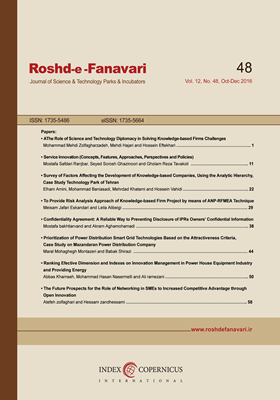بررسی عوامل مؤثر بر پیشرفت شرکتهای دانشبنیان با استفاده از تحلیل سلسله مراتبی، مطالعه موردی پارک تهران
الموضوعات : مديريت تکنولوژيالهام امینی 1 , محمد بنی اسدی 2 , مهرداد حاتمی 3 , حسین وحیدی 4
1 - دانشگاه علوم پزشکی بم
2 - دانشگاه علوم پزشکی بم
3 - دانشگاه علوم پزشکی بم
4 - دانشگاه شریف
الکلمات المفتاحية: شرکتهای دانشبنیان عوامل مؤثر تحلیل سلسله مراتبی رتبهبندی دانشمحور,
ملخص المقالة :
اقتصاد دانشبنیان اقتصاد نوینی است که در آن تولید، توزیع و استفاده از دانش، منبع اصلی رشد و ایجاد ثروت است. موتور محرک اقتصاد دانشبنیان شرکتهای دانشبنیان هستند. تحقیق حاضر در مطالعهای موردی با استفاده از تحلیل سلسله مراتبی به بررسی عوامل مؤثر بر پیشرفت این شرکتها، در پارک دانشگاه تهران پرداخته است. برای این منظور، نظرسنجی از دو گروه هدف، شامل مدیران شرکتها و کارشناسان خبرۀ وزارت بهداشت انجام شده است و برای امتیازدهی از روش تحلیل سلسله مراتبی استفاده شده است. تکنیک AHP بطور گسترده در حوزههای مختلف تصمیمگیری چند معیاره از قبیل ارزیابی، برنامهریزی و توسعه، تصمیمگیری و پیشبینی بکار گرفته شده است. برای این منظور 8 عامل مهم شامل عوامل فناوری، اجتماعی، شرایط بازار، سیاسی، مدیریتی، اقتصادی، قانونی و زیستمحیطی بررسی شده است و نظرات دو گروه هدف مذکور با هم مقایسه شدهاند. همانطور که از نتایج مشخص است، تمامی عوامل مورد بررسی یعنی فناوری، مدیریت، بازار، اقتصاد، قوانین، سیاست، اجتماعی و محیطزیست از نظر هر دو گروه هدف بر پیشرفت شرکتهای دانشبنیان اثر داشتند. شاخصهای فناوری، اقتصاد و قوانین به ترتیب سه فاکتور اصلی و تأثیرگذار از دیدگاه مدیران شرکتهای دانشبنیان شناخته شده است. معیارهای محیطزیست، اجتماعی و سیاست کم اهمیتترین انتخاب شدهاند. در صورتیکه کارشناسان خبرۀ وزاتخانه مسائل مدیریتی را بهعنوان فاکتور اصلی در نظر گرفتهاند.
1- موسایی، احمد. طراحی مدلی جهت تعیین فرصت ها و تجاری سازی آنها در مراکز تحقیق و توسعه. مجله رشد فناوری4 (14): 13-21. (1387).#
2- علم خواه، حسن. شجاع، جواد. راهنمای مالکیت فکری برای کسب و کارهای تجاری (با تأکید بر شرکت های دانش بنیان). 110-111. (1390).#
3- جهاندیده، محسن. اخوان فرد، مسعود. تجاری سازی نتایج تحقیق، سومین کنفرانس بین المللی مدیریت،.( 1384).#
4- فکور، بهمن. تجاری سازی نتایج تحقیقات. نشریه رهیافت.. شماره 24. صص 53-58. (1383).#
5- اکبرزاده، نجمه. شفیع زاده، احسان. بررسی نقش دولت در بهبود روند ایجاد و توسعه کسب و کارهای دانش بنیان. رشد فناوری. شماره 33. (1391). #
6- جمشید، پژمان. لشکری زاده، مریم. بررسی عوامل تأثیرگذار بر رابطه میان رشد اقتصادی و کیفیت زیستی. پژوهش های اقتصادی ایران. شماره 42. صص 169-188. (1389). #
7- D. M. Amidon, "Origin of the knowledge- based firms," Management Systems Research, vol. 7, pp. 212-223, 2001.#
8- K. T. P. McMullan E.W., Creativity and Entrepreneurial Performance: A General Scientific Theory Exploring Diversity in Entrepreneurship: Springer, 2014.#
9- R. Landry, N. Amara, and M. Ouimet, "Determinants of knowledge transfer: evidence from Canadian university researchers in natural sciences and engineering," The Journal of Technology Transfer, vol. 32, pp. 561-592, 2006.#
10- B. Van Looy, M. Ranga, J. Callaert, K. Debackere, and E. Zimmermann, "Combining entrepreneurial and scientific performance in academia: towards a compounded and reciprocal Matthew-effect?," Research Policy, vol. 33, pp. 425-441, 2004.#
11- Y.-M. Wang, Y. Luo, and Z. Hua, "On the extent analysis method for fuzzy AHP and its applications," European Journal of Operational Research, vol. 186, pp. 735-747, 2008.#
12- B. Şener, M. L. Süzen, and V. Doyuran, "Landfill site selection by using geographic information systems," Environmental Geology, vol. 49, pp. 376-388, 2005.#
13- K. M. A.-S. Al-Harbi, "Application of the AHP in project management," International Journal of Project Management, vol. 19, pp. 19-27, 2001.#
14- T. L. Saaty, "Desicion making by the analytic hierarchy process: Theory and applicationsHow to make a decision: The analytic hierarchy process," European Journal of Operational Research, vol. 48, pp. 9-26, 1990/09/05 1990.#
15- M. P. Amiri, "Project selection for oil-fields development by using the AHP and fuzzy TOPSIS methods," Expert Systems with Applications, vol. 37, pp. 6218-6224, 2010.#
16- D.-R. Liu and Y.-Y. Shih, "Integrating AHP and data mining for product recommendation based on customer lifetime value," Information & Management, vol. 42, pp. 387-400, 2005.#
17- J. K. Musango and A. C. Brent, "A conceptual framework for energy technology sustainability assessment," Energy for Sustainable Development, vol. 15, pp. 84-91, 2011.#
18- R. Shagholi and S. Hussin, "Participatory management: an opportunity for human resources in education," Procedia - Social and Behavioral Sciences, vol. 1, pp. 1939-1943, 2009.#
19- M. Caetano and D. C. Amaral, "Roadmapping for technology push and partnership: A contribution for open innovation environments," Technovation, vol. 31, pp. 320-335, 2011.#
20- A. S. Dunk, "Product innovation, budgetary control, and the financial performance of firms," The British Accounting Review, vol. 43, pp. 102-111, 2011.#
21- F. T. Rothaermel, "Complementary assets, strategic alliances, and the incumbent’s advantage: an empirical study of industry and firm effects in the biopharmaceutical industry," Research Policy, vol. 30, pp. 1235-1251, 2001.#
22- E. F. Levitas, M. A. McFadyen, and D. Loree, "Survival and the introduction of new technology: A patent analysis in the integrated circuit industry," Journal of Engineering and Technology Management, vol. 23, pp. 182-201, 2006.#
23- F. Asllanaj, A. Milandri, G. Jeandel, and J. R. Roche, "A finite difference solution of non-linear systems of radiative–conductive heat transfer equations," numerical methods in engineering, vol. 54, pp. 1649–1668 2002..#
24- M. A. Y. Mohan Subramaniam, "the influence of intellectual capital on the types of innovative capabilities," AOM, vol. 48, pp. 450-463, 2005.#
25- A. Kaasa, "Effects of different dimensions of social capital on innovative activity: Evidence from Europe at the regional level," Technovation, vol. 29, pp. 218-233, 2009.#
26- Khayatian, Mohammadsadegh Tabatabaeian, seyed habibollah amiri, maghsod elyasi, mehdi. Analysis of the factors influencing the growth and sustainability of Knowledge based firms in Iran. vol.2, pp.57-74. 2015.#


